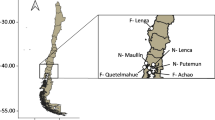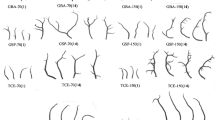Abstract
Chondracanthus chamissoi is a red alga which is acquiring an increasing economic importance in Chile and becoming a target species for cultivation. Because epiphytism is a major problem in the mariculture of seaweeds, the recruitment of Ulva sp. and Enteromorpha sp. on gametophytic (cystocarpic) and tetrasporophytic thalli of C. chamissoi was tested in vitro on four populations from different locations in Chile. For Ulva sp., the density, cover and length of the recruits varied between the reproductive phases of the host and among the studied populations of C. chamissoi. In most experiments, a larger number of epiphytic thalli was observed on gametophytic plants of C. chamissoi; populations from Calderilla and Lechagua had a higher resistance to epiphytism. For Enteromorpha sp., its ability to grow epiphytically on both phases of the host showed a greater variability, but was inferior to that of Ulva sp. The differential resistance to epiphytism in both reproductive phases and in plant origin indicates the possibility of obtaining selected strains of C. chamissoi with lower susceptibility to epiphytism that could be utilized in planning maricultural programs.


Similar content being viewed by others
References
Acleto C (1986) Algunos aspectos biológicos de Gigartina chamissoi (C. Ag.) J. Agardh (Rhodophyta, Gigartinales). Rev Cs Univ Nac San Marcos 74:33–47
Ask EI, Azanza RV (2002) Advances in cultivation technology of commercial eucheumatoid species: a review with suggestions for future research. Aquaculture 206:257–277
Bouarab K, Potin P, Correa J, Kloareg B (1999) Sulfated oligosaccharides mediate the interaction between a marine red alga and its green algal pathogenic endophyte. Plant Cell 11:1635–1650
Bouarab K, Potin P, Weinberger F, Correa J, Kloareg B (2001) The Chondrus crispus Acrochaete operculata host-pathogen association, a novel model in glycobiology and applied phycopathology. J Appl Phycol 13:185–193
Bulboa CR (2001) Aspectos reprodutivos e biológicos de Kappaphycus alvarezii (Doty) Doty ex P. Silva e K. striatum (Schmitz) Doty (Gigartinales, Rhodophyta). Bases para introdução e cultivo de espécies exóticas no litoral brasileiro, Dissertation, Universidade de São Paulo
Bulboa CR, Macchiavello JE (2001) The effects of light and temperature on different phases of the life history in the carrageenan producing alga Chondracanthus chamissoi (Rhodophyta, Gigartinales). Bot Mar 44:371–374
Bulboa CR, Macchiavello JE, Oliveira EC, Fonck E (2005) First attempt to cultivate the carrageenan-producing seaweed Chondracanthus chamissoi (C. Agardh) Kutzing (Rhodophyta; Gigartinales) in Northern Chile. Aquac Res 36:1069–1074
Buschmann AH, Gómez P (1993) Interaction mechanisms between Gracilaria chilensis (Rhodophyta) and epiphytes. Hydrobiologia 261:345–351
Buschmann AH, Kuschel FA, Vergara PA, Schulz J (1992) Intertidal Gracilaria farming in southern Chile-differences of the algal proveniance. Aquat Bot 42:327–337
Cho JY, Kwon EH, Choi JS, Hong SY, Shin HW, Hong YK (2001) Antifouling activity of seaweed extracts on the green alga Enteromorpha prolifera and the mussel Mytilus edulis. J Appl Phycol 13:117–125
Craigie JS, Leigh C (1978) Carrageenans and agar. In: Hellebust JA, Craigie JS (eds) Physiological and biochemical methods. Cambridge University Press, Cambridge, pp 109–131
D’Antonio C (1985) Epiphytes on the rocky intertidal red alga Rhodomela larix (Turner) C Agardh: negative effects on the host and food for herbivores? J Exp Mar Biol Ecol 86:197–218
de Nys R, Steinberg PD, Willemsen P, Dworjanyn SA, Gabelish CL, King RJ (1995) Broad spectrum effects of secondary metabolites from the red alga Delisea pulchra in antifouling assays. Biofouling 8:259–271
Edwards P (1970) Illustrated guide to the seaweeds and sea grasses in the vicinity of Porto Aransas, Texas. Contr Mar Sci Suppl 15:1–228
Fletcher RL (1995) Epiphytism and fouling in Gracilaria cultivation: an overview. J Appl Phycol 7:325–333
Garcia-Jimenez P, Marian FD, Rodrigo M, Robaina MM (1999) Sporulation and sterilization method for axenic culture of Gelidium canariensis. J Biotechnol 70:227–229
González J, Meneses I (1996) Differences in the early stages of development of gametophytes and tetrasporophytes of Chondracanthus chamissoi (CAg) Kutzing from Puerto Aldea, Northern Chile. Aquaculture 143:91–107
González J, Meneses I, Vásquez JA (1997) Field studies in Chondracanthus chamissoi (C. Agardh) Kutzing: seasonal and spatial variations in life cycle phases. Biol Pesq 26:3–12
Harder T, Dobretsov S, Qian P (2004) Waterborne polar macromolecules act as algal antifoulants in the seaweed Ulva reticulata. Mar Ecol Prog Ser 274:133–141
Hayden HS, Blomster J, Maggs CA, Silva PC, Stanhope MJ, Waaland JR (2003) Linnaeus was right all along: Ulva and Enteromorpha are not distinct genera. Eur J Phycol 38:277–294
Hellio C, Berge JP, Beaupoil C, Le Gal Y, Bourgougnon N (2002) Screening of marine algal extracts for anti-settlement activities against microalgae and macroalgae. Biofouling 18:205–215
Hellio C, Marechal JP, Veron B, Bremer G, Clare AS, Le Gal Y (2004) Seasonal variation of antifouling activities of marine algae from the Brittany coast (France). Mar Biotechnol 6:67–82
Hoffmann A, Santelices B (1997) Flora Marina de Chile Central. Ediciones Universidad Católica de Chile, Santiago, Chile
Jennings JG, Steinberg PD (1997) Phlorotannins versus other factors affecting epiphyte abundance on the kelp Ecklonia radiata. Oecologia 109:461–473
Kuschel FA, Buschmann AH (1991) Abundance, effects and management of epiphytism in intertidal cultures of Gracilaria (Rhodophyta) in Southern Chile. Aquaculture 92:7–19
Lüning K, Pang SJ (2003) Mass cultivation of seaweeds: current aspects and approaches. J Appl Phycol 15:115–119
Oliveira EC, Paula J, Plastino M, Petti R (1995) Metodologias para el cultivo no axénico de macroalgas marinas in vitro. In: Alveal K, Ferrario ME, Oliveira E, Sar E (eds) Manual de métodos ficológicos. Universidad de Concepción, Concepción, pp 429–447
Oliveira EC, Alveal K, Anderson RJ (2000) Mariculture of the agar-producing Gracilarioid red algae. Rev Fish Sci 8:345–377
Ramírez ME, Santelices B (1991) Catálogo de las algas marinas bentónicas de la costa temperada del del Pacifico de Sudamerica. Monografías Biológicas 5
Rothäusler E, Macaya EC, Molis M, Wahl M, Thiel M (2005) Laboratory experiments examining inducible defense show variable responses of temperate brown and red macroalgae. Rev Chil Hist Nat 78:603–614
Santelices B (1992) Strain selection of clonal seaweeds. In: Round FE, Chapman DJ (eds) Progress in phycological research. Biopress, Bristol, pp 85–116
Santelices B, Ugarte R (1990) Ecological differences among Chilean population of commercial Gracilaria. J Appl Phycol 2:17–26
Santelices B, Varela D (1993) Exudates from Gracilaria chilensis stimulate settlement of epiphytic ulvoids. Hydrobiologia 261:327–333
Steinberg PD, de Nys R, Kjelleberg S (1998) Chemical inhibition of epibiota by Australian seaweeds. Biofouling 12:227–244
Trono G (1993) Eucheuma and Kappaphycus: taxonomy and cultivation. In: Ohno M, Critchley AT (eds) Seaweed cultivation and marine ranching. Japan International Cooperation Agency, Kanagawa, Japan, pp 75–88
Vásquez JA, Vega JM (2001) Chondracanthus chamissoi (Rhodophyta, Gigartinales) in Northern Chile: ecological aspects for management of wild populations. J Appl Phycol 13:267–277
Wheeler W, Neushul M, Harger B (1981) Development of a coastal marine farm and its associated problems. In: Levring T (ed) Proceedings of the Tenth International Seaweed Symposium. Walter de Gruyter, Berlin, pp 631–636
Acknowledgements
C. Bulboa is grateful to the Red Latinoamericana de Botánica (RLB - Tyler Prize 2004) for the PhD fellowship. We are grateful to Jaime Montenegro, Francisco Galleguillos and Eduardo Gómez for assistance in the field. We wish to thank Dr. Joe Zuccarello for correction of the English and helpful comments on the manuscript.
Author information
Authors and Affiliations
Corresponding author
Rights and permissions
About this article
Cite this article
Bulboa, C.R., Macchiavello, J.E., Veliz, K. et al. In vitro recruitment of Ulva sp. and Enteromorpha sp. on gametophytic and tetrasporophytic thalli of four populations of Chondracanthus chamissoi from Chile. J Appl Phycol 19, 247–254 (2007). https://doi.org/10.1007/s10811-006-9130-y
Received:
Accepted:
Published:
Issue Date:
DOI: https://doi.org/10.1007/s10811-006-9130-y




